Alaska Economic Trends
Alaska Economic Trends is a monthly magazine that covers a range of economic topics.
Sign up for a free electronic subscription. 
Sign up for a paid print subscription.
Alaska Economic Trends are searchable from 1961 to the present using the Trends search page. The search can include any combination of the following: Key Words, Date Range, Author, Category
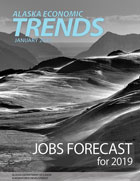
After three years of job losses, Alaska is set to regain a small amount of lost ground in 2019 as some industries show signs of recovery. We forecast 0.4 percent growth in 2019, or about 1,400 new jobs.
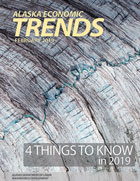
Two months into 2019, here are a few basic things to understand about Alaska's economy and job market as we teeter between resumed growth and a lingering recession.
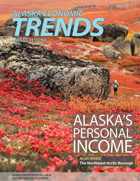
Alaska residents brought in $42.3 billion in personal income in 2017. Dividing that total by the number of residents - adults and children alike - puts 2017's per capita income at $57,179.
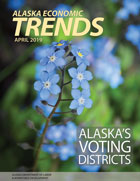
The next decennial census will be conducted early next year. While the census provides a multitude of statistics and is used to distribute government funds, its primary purpose is the reapportionment and redistricting of the U.S. House of Representatives and state legislatures across the country. This once-a-decade process is a good barometer for how the population's distribution has changed.

Mining is a colorful part of Alaska's past. There are ghost town tours of Kennecott Mine, Skagway exists and thrives because of its gold rush history, and Treadwell Mine tailings created Sandy Beach in Juneau. But mining is also an important part of Alaska's current economy and will almost certainly play a growing role in its future.

The number of Alaskans who are 65 or older is growing rapidly in all regions of the state. This shift to larger senior populations across Alaska will play an important role in shaping our communities and households in the coming years.
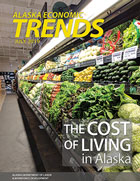
Until 2018, the story on price increases had been the same for three years straight. The state's single consumer price index registered inflation of 0.5 percent or less each year from 2015 through 2017, which was the lowest period for inflation in Alaska's history. This was largely due to the weak housing market tied to Alaska's recession, which began in late 2015.
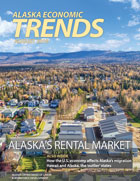
Rents fell slightly in 2019 and vacancies rose, according to our annual survey of Alaska landlords. The increase in vacancies continues a three-year trend that has pushed the overall vacancy rate to a 10-year high of 8.6 percent. Rental costs and the broader housing market remained mostly stable throughout Alaska's recession (see the August 2018 issue of Trends), but the continued rise in vacancy suggests the state's weak economy is hurting the rental market.

While women represent nearly half of Alaska's workers and hold more of the positions requiring higher education, they earn 72 percent of what men make, on average. A number of factors influence the gender gap in wages, and many studies have tried to measure and explain them, but that type of analysis is outside this article's scope.

As Alaska wrestles with an ongoing budget imbalance, one of the questions we face is how much government we want and need. One step toward making that policy decision is understanding how Alaska's government job numbers and wages line up with other states and why states differ.
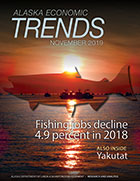
Alaska's seafood harvesting employment dropped 4.9 percent in 2018, erasing most of the prior year's gains. While some fisheries added jobs, they weren't enough to offset the losses in salmon fishing, which represents the largest share of the state's harvesting employment.
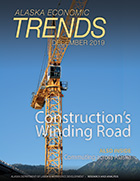
After two years of big job losses, Alaska's construction industry started growing again in 2018 and continued adding jobs in 2019. It will likely take several years for the industry to recover lost ground, however.
